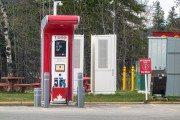After releasing our report Making Tracks to Torontonians early this year, we learned that a new hybrid transit plan for Toronto was in the works — a compromise between Mayor Ford's subway extension and the light rail plan that was underway before Ford became mayor.
Here at the Pembina Institute, we have been sharpening our pencils, poised to analyze the new plan as soon as it hits the table. Not knowing what this new plan will look like, we have been preparing for its unveiling by considering possible scenarios — what a compromise between Transit City and the proposed subway plan might look like, what it should look like, and what's best for Toronto.
Here are some — though definitely not all — of the criteria will we be looking for when the new plan hits the light of day:
1. Is it cost-effective?
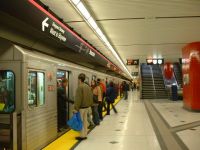 With limited funds available for transit for the next ten years, a plan should aim to bring rapid transit to the doorsteps of as many Torontonians as possible.
With limited funds available for transit for the next ten years, a plan should aim to bring rapid transit to the doorsteps of as many Torontonians as possible.
Of all the transit lines on the table, Ford's proposed Sheppard subway line is the contentious budget-buster, because it will cost four times as much per kilometre than light-rail transit (LRT) would on that same line. Eight kilometres of Sheppard subway would chew through one-third of the total available transit budget for the next ten years, potentially using up funding that could go toward building rapid transit elsewhere.
An LRT line along Sheppard is a third of the cost of a subway. This means those extra funds could be used to build transit in other parts of the city as well, like the much-needed Finch line.
2. Does the plan include Finch?
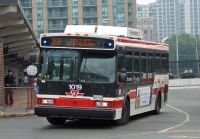 Finch West 36 is currently the busiest bus route in Toronto right now, and, given projected population growth, it will only get busier. The current bus service cannot support the demand; Finch needs rapid transit with greater capacity and frequency.
Finch West 36 is currently the busiest bus route in Toronto right now, and, given projected population growth, it will only get busier. The current bus service cannot support the demand; Finch needs rapid transit with greater capacity and frequency.
The northwest suburbs of Toronto have the highest and fastest-growing percentage of low-income, immigrant, single parent and youth populations in the city. Many of these residents cannot afford vehicles and have to travel further to find employment, yet they currently are the most underserved by rapid transit. A recent University of Toronto study found that lack of transit access is a main cause of increasing poverty in these areas, and that providing rapid transit to these neighbourhoods would help to reverse this trend.
It makes no sense not to include Finch. The residents there need it, and the proposed Finch LRT is the most cost-effective transit line on the table. For less than $1 billion, it's an 11-kilometre bargain; compare that to eight kilometres of subway along Sheppard for $3 billion.
The lowest-income areas in Toronto are the northern fringe of North York and almost all of Etobicoke north of Eglinton Ave., as well as large parts of the former municipalities of York and East York. The Finch and Eglinton lines would serve four of these regions.
Finally, a Finch LRT would not take away any lanes of traffic, so those who do drive will not lose pavement to transit.
3. Is it fiscally responsible — now and in the long term?
I've been reading studies by the TTC dating back over 10 years that stress the need to match rapid transit expansion with the necessary level of density. Otherwise, there will never be enough riders to pay for the operation of a subway, let alone paying back the capital expense to build it.
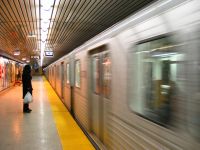 For subways to be cost-effective they require a minimum peak (rush hour) ridership of 10,000 to 15,000, depending on frequency of service. For LRT lines to be cost effective they require at least 3,000 to 5,000 riders at peak.
For subways to be cost-effective they require a minimum peak (rush hour) ridership of 10,000 to 15,000, depending on frequency of service. For LRT lines to be cost effective they require at least 3,000 to 5,000 riders at peak.
Here's the problem: The peak ridership of the Sheppard line in 2031 is projected to be somewhere between 3,000 and 5,500 riders depending on technology — well below the minimum ridership required to justify subway.
Subways are critical in Toronto's downtown core, where the population density requires rapid transportation with the capacity to carry many passengers at once. However, in less dense neighbourhoods, the most important factor is not capacity, but level of service — is transit frequent and reliable, or even available at all? Population density along Sheppard is too low to support a subway; there likely will not be enough riders to pay it off, and the burden of debt will preclude the further development of rapid transit that is badly needed in this city.
|
Cost-effectiveness of Sheppard East |
LRT (Phase 1) |
Subway |
|
Length (km) |
12 |
8 |
|
Cost ($2010 billions) |
$1.0 |
$2.9 |
|
Cost per km ($2010 millions) |
$85 |
$360 |
|
Projected peak ridership - number of projected rush hour commuters* |
3,100 |
5,300 |
|
Peak ridership required to be cost effective |
3,000-5,000 |
10,000-15,000 |
*passengers per hour per direction
4. What about Eglinton?
After talking through the options with various stakeholders over the past month, I cannot think of anyone who opposes an LRT line on Eglinton, which has the highest projected ridership of any of the current options on the table.
Phase One of the "Eglinton Crosstown" line, as it is called, would span 19 kilometres from Kennedy station to Jane and bring rapid transit to the doorsteps of 340,000 Torontonians. Phase Two would extend all the way to Pearson airport.
Construction could start right away on the 11-kilometre underground section of Eglinton - we have already bought and paid for the boring machines for this work. However, the whole point of Eglinton Crosstown is to create a complete link across the city. The eight kilometers of above-ground rail should be included in a new plan, otherwise we will end up with a tunneled section that does not actually go "cross town" to Kennedy or connect to the westerly beginnings of the airport-bound Phase Two.
5. Can we get shovels in the ground right away?
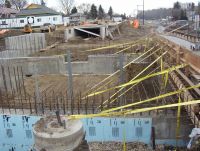 Clearly, one of the positive aspects of the Transit City plan was that much of the groundwork had already been done on the four priority transit lines, including time-consuming environmental assessments. Work had commenced on some lines and, had the plan not been delayed, boring machines would have been tunneling the underground section of Eglinton right now.
Clearly, one of the positive aspects of the Transit City plan was that much of the groundwork had already been done on the four priority transit lines, including time-consuming environmental assessments. Work had commenced on some lines and, had the plan not been delayed, boring machines would have been tunneling the underground section of Eglinton right now.
Toronto is in a transit deficit, and we cannot afford to cancel plans in motion and delay transit construction. For that reason, a new transit plan should prioritize certain lines where construction can start immediately, such as the Eglinton Crosstown.
Looking forward
Just a quick overview of characteristics we'll be watching for in any new hybrid transit plan that surfaces in Toronto. While we're waiting for that plan to appear, our team is developing a position paper reflecting Pembina's analysis and recommendations for how a hybrid subway–LRT transit plan could best serve Torontonians — both today, and as the city grows in the future.


